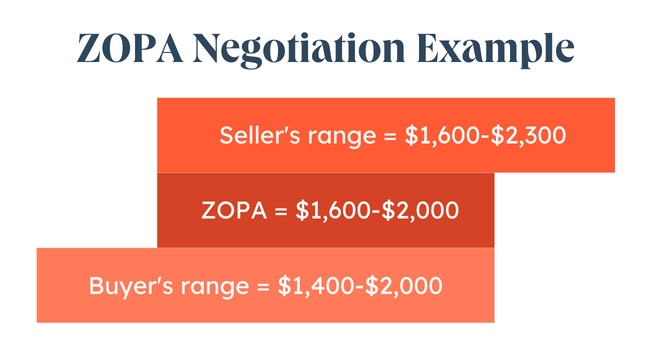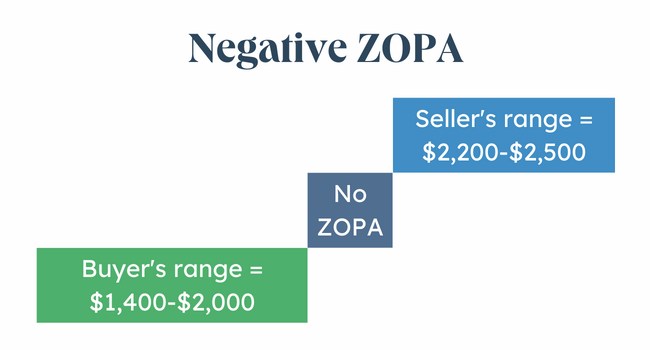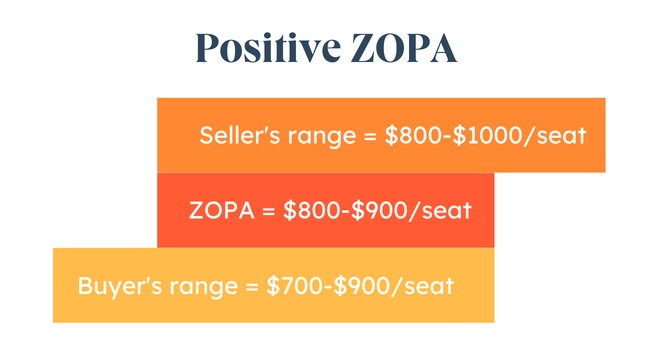You probably didn’t know about ZOPA negotiation when you bought your first car. As you drove it off the lot, did you wonder if you paid too much? Did you get the features you wanted?
Negotiating is a lot of fun for some people, and super stressful for others. Whether you’re bargaining for your business or yourself, the zone of possible agreement is a negotiating technique that can help anyone get comfortable with bargaining.
This post will explain what ZOPA and bargaining zones are and how to use these tactics for getting to yes during any negotiation.
Keep reading, or jump ahead to the section you’re looking for:
- What is the zone of possible agreement (ZOPA)?
- What is a Bargaining Zone?
- How to Find the Zone of Possible Agreement
- ZOPA Negotiation Examples
What is ZOPA in Negotiation?
While ZOPA is also the name of a bank and a rock band based in New York, most references to ZOPA are about the negotiation process.
Your zone of possible agreement is the area where an agreement is satisfactory to both negotiating parties. It’s essentially the overlap area between walk-away positions in a negotiation.

For example, say you’re willing to spend $2,000 on a new mountain bike, and the seller wants to get at least $1,800 for it. The zone of possible agreement is from $1,600-$2,000, so you have $400 of common ground to find a compromise.
The tricky part? You typically don’t know the size of the bargaining zone when going into a negotiation — you only know your side of the range.
That’s because no one wants to reveal the bare minimum they’re willing to accept. Would you jump to tell the seller you’re open to spending $2,000 if you knew you could get the bike for $1,600? Not exactly.
This veil of secrecy makes the zone of possible agreement tricky to navigate. But if you know how to negotiate within it, you can reach an agreement that incorporates some must-haves from each side.
This is how people wind up striking a deal and walking away satisfied. When people fail to reach an agreement, it’s usually because the bargaining zone doesn’t line up. This is called the negative bargaining zone, and it can throw your discussions for a loop.
What is a negative bargaining zone?
If there’s no overlap between two negotiating parties, everyone involved is operating within a negative bargaining zone (or negative ZOPA). At this point, those parties can only reach an agreement if one of the parties is open to adjusting their terms.

Returning to the example above, you’d be locked in a negative bargaining zone if you wanted to spend no more than $2,000, but the seller won’t accept a price below $2,200. You’re not walking away with a new two-wheel ride until someone is willing to budge.
Negotiations can evaporate in the negative bargaining zone. If you find yourself here, there are ways out — you simply have to make your way into the positive zone.
What is a positive bargaining zone?
Negotiations are in the positive bargaining zone (or Positive ZOPA) when all parties have some sort of overlapping terms. The price, conditions, or delivery schedule match up — and it’s possible to come to an agreement that works for everyone.

Let’s share another example. Say you’re selling a software package to a B2B client. The listed price for the software is $1000 per seat, but the sale price is $800 per seat. Your clients have shared that they’re looking for a price of $900 per seat. So, the price your client wants to pay is in the range of what you want to get for the sale.
You can be in a positive bargaining zone without even realizing it. You often don’t know the boundaries of the person you’re negotiating with, so you’ll have to work to find out whether you’re in a positive or negative zone.
Using the tips below, you can find out the limits of the ZOPA and land on terms that make both sides happy.
All negotiations are dynamic. You may come in with an idea of what you want, but that can change as conversations flow. A price that’s acceptable from the start may get turned down a day later. A timeline that seemed concrete could change as teams re-prioritize a project. A base salary can adjust with extra vacation days or stock options.
This constant fluctuation is why people have to understand one another’s needs, interests, values, and must-haves. You have to know yourself and your needs well — and then work to figure out the same details for the other side. Here’s how to go about it.
1. Know your BATNA.
A BATNA — or best alternative to a negotiated agreement — is a clear walkaway line that establishes a baseline for the negotiation. It can be a bottom-line price, the soonest delivery date, or the lowest sales commission percentage.
In short, to find your ZOPA, figure out your BATNA.
Keep in mind, a BATNA is provisional and can flex as conversations flow. But typically, it’s what a party is willing to accept in the worst-case situation before walking away.
Even with an established BATNA, you only know one side of the bargaining zone. Your counterpart’s BATNA is unclear — which is why the back-and-forth dance of offers and counteroffers happens. Both sides are trying to figure out what the walkaway line is, and they often get as close to that line as possible.
2. Do your research.
The work you put in before a negotiation is often more important than the act itself.
Figuring out what matters to you and what you want out of a negotiation can help you save time and energy. It also keeps you from focusing on details that don’t move you closer to your ideal outcome.
Preparing helps you clarify what’s at stake, what your interests are, what each party is aiming to walk away with, and the possible issues that may come up.
Preparation alone may not get you everything you want. That said, it can give you the confidence to lay out your terms, consider the other side’s perspective, and be clear about your ZOPA boundaries.
This research may include:
- Market research
- Getting to know your prospects
- Creating a company profile
- Competitive analysis
- Understanding common issues and solutions
- Industry trends
- SWOT analysis
3. Set your boundaries.
It can sometimes be more comfortable to adjust your boundaries once you begin a negotiation. But it’s more effective to set your own boundaries early on.
Even if your boundary is flexible, creating set boundaries for negotiations can give you a more solid foundation for the ZOPA.
For example, say you’re negotiating your salary at a new job. You’re willing to accept a salary of $85,000, but your ideal low salary is $92,000. If you set a boundary at $92K instead of $85K, you’re more likely to communicate a range to your potential employer for the best possible ZOPA.
This step sounds easy, but it may require some time and thought. Give yourself that space to make sure that you’re setting your boundaries before the person you’re negotiating with sets them for you.
4. Anticipate expectations.
The ZOPA in negotiation is a moving target. During a negotiation, you will balance your boundaries and expectations against those of another party. Whether it’s a friend, opponent, or enterprise, it’s important to anticipate their expectations.
For example, during a game like the Superbowl, the action doesn’t just happen on the field. Before the game teams rehearse plays designed to anticipate the plays of the opposing team.
The most successful parts of the game can sometimes be moments that don’t look like much to the audience. This is often because the team prepared for that play so perfectly there was no forward or backward motion. This gives that team a better opportunity to benefit from the next play.
Negotiators hope for these kinds of results too. They use different negotiation skills and tactics to shape the ZOPA in their favor. Whether you’re worried about emotional reactions or making tough decisions, try to understand what the person you’re negotiating with is expecting from you.
Then, try to meet those expectations in a genuine way that helps you reach your ideal result.
5. Be curious.
Great negotiators don’t brawl their way through a deal. They build trust, come up with creative solutions, find trade-offs, and offer alternatives. How? By being curious.
If you’re trying to figure out the other side’s BATNA and understand the bargaining zone limits, you have to ask open-ended questions and learn what matters to them. You can start with some of these:
- How’s business these days?
- What are your top three must-haves for this agreement?
- How do you imagine rolling out this project?
- Can you tell me more about how having high-quality leads will impact your company?
- How do you think your current process could be improved?
- Can you explain why XYZ is a non-negotiable for you?
Try not to jump into pricing conversations and anchoring. Instead, listen to their answers to learn what’s on the table. Maybe they have money to spend but need a high-quality deliverable. Maybe they want a quick delivery, but they’re willing to offer resources to help get it done. The more curious you are, the clearer the zone of possible agreement becomes.
6. Stay flexible.
Remember, the ZOPA will often change throughout a negotiation. It shifts as each party learns more about the other side, refines its priorities, and reconsiders its BATNA. Staying flexible in the face of these swings is essential to a successful negotiation.
Seasoned negotiators can tell when a sudden change makes someone flustered or desperate. They know when they’re beginning to gain leverage and will use it to their advantage to get a more favorable agreement. But they can also tell when they’re losing steam. This moment is the perfect time to take action.
Staying flexible might mean bending to others’ boundaries, letting go of secondary goals, or adapting to changing circumstances. It also might mean a longer conversation. Sometimes negotiators can rush to a result and miss crucial details. Instead, focus on listening and dialogue throughout the negotiation.
Stay calm, ignore aggressive tactics, and note unacceptable terms. This can keep you open to changes during a negotiation. It can lead other negotiators to assume you have nothing to lose. This can then lead them to reconsider their own terms — possibly moving from a negative bargaining zone to a positive one.
7. Expect the unexpected.
The negotiation process isn’t just about skills, strategy, and techniques. Emotions, luck, and surprising new information can all change the zone of possible agreement.
While persuasion is often a focus for negotiating beginners, you’ll also need to understand how to respond to the unexpected. Abrupt change can be a gift or a curse, depending on how you deal with it. You’ll need to figure out how to limit harm and amplify the positive in each twist and curve of the conversation.
No matter how well-prepared you are, each negotiation will come with something you don’t expect. If you can find a way to quickly transform that shock into creative solutions, you’ll create the best ZOPA for yourself and your business.
8. Consider the whole picture.
As the bargaining zone shifts, it will likely affect the other terms on the table. That’s why it’s important to keep a holistic view of the negotiation. You don’t want to zone in on one aspect of a deal and forget about the whole picture.
Maybe you’re willing to budge on the price by offering a discount because you’ll gain a long-term customer. Or maybe you accept a rush project because your team has the capacity, and you know it will be business as usual the following month.
Any time the conversation stalls on a specific detail, keep the conversation going by opening up to the big picture. Think about the party you’re negotiating with first, then how you can reach your goals by meeting their needs.
Keeping the overall outcome in mind will help you work toward more favorable terms and let you nudge the other side closer to their walkaway limit.
ZOPA Negotiation Examples
Now that you understand the bargaining zone, take a look at these real-world examples to see what it looks like to reach (or walk away from) an agreement.
The Yankees and YES
For example, the video below highlights the Yankees’ negotiating skills with its deal for local broadcast rights.
Chicago Teachers’ Strike
In 2011, the Mayor of Chicago, Rahm Emanuel, upset the Chicago Teachers Union (CTU) by repealing a promised pay raise and lobbying to limit the union’s ability to go on strike. The two parties began negotiations but couldn’t reach an agreement after delays from the city caused months of back and forth. In 2012, the teachers went on a 10-day strike.
Eventually, both sides agreed to adjust their terms and come to a compromise. The teachers won their struggle for annual raises, and the city got to extend the school day. The strike has also had long-lasting impacts on local and national policies and conditions for educators.
This example shows how delaying negotiations and strict boundaries can create a negative bargaining zone instead of a zone of possible agreement.
Minnesota Orchestra Dispute
To decrease its financial struggles, the Minnesota Orchestra management team suggested reducing musicians’ salaries by almost a third. The players promptly turned down the proposal and refused to make a counteroffer. This led to a lockout and months of canceled concerts.
With the deadline approaching, community groups raised money to offer the musicians a bonus to lower their pay reduction. The musicians rejected the offer, the director resigned, and the Orchestra endured a 16-month lockout until the players eventually accepted a pay reduction.
This standoff was “the nation’s longest-running contract dispute for a concert orchestra.” This example shows how important it is to stay flexible and open-minded when negotiating to find solutions that may lead to an agreement.
The next time you hear about a deal like Microsoft’s acquisition of Activision, Amazon and MGM, or Disney’s purchase of Lucasfilm, take a look at the details. Think about the negotiation skills that went into these deals.
Zopa Negotiation Can Help You Make Better Bargains
To maneuver a negotiation, all parties have to work toward a common goal along the zone of possible agreement. Try using these tips to shift from a negative to a positive bargaining zone.
These strategies can help you find what someone is willing to accept. And you can use the ZOPA as a benchmark to make a deal that’s favorable for you and the parties you’re bargaining with.
Editor’s note: This post was originally published in August 2021 and has been updated for comprehensiveness.

![]()


![Read more about the article AI in B2B Sales: How It’s Used and It’s Biggest Benefits [New Data]](https://www.dimaservices.agency/wp-content/uploads/2023/06/9cdc68ed-d735-4161-8fea-0de2bab95cef-1-300x37.png)

